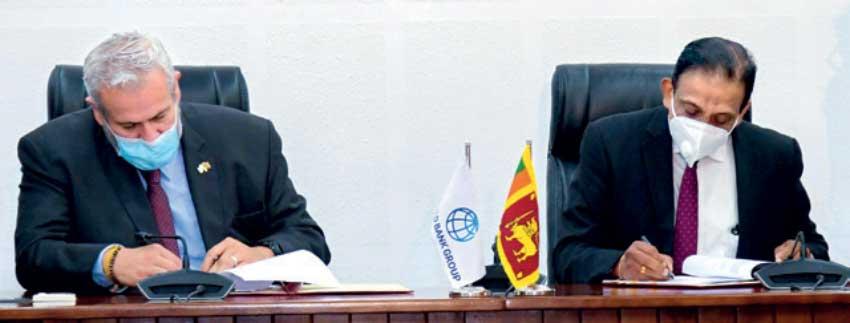23 Apr 2021 - {{hitsCtrl.values.hits}}

Finance Ministry Secretary S.R. Attygalle and World Bank Country Director the Maldives, Nepal and Sri Lanka Faris H. Hadad-Zervos signed the agreement on behalf of the government and World Bank, respectively
The Government of Sri Lanka and World Bank have signed a US $ 69.33 million loan agreement for the Kandy Multimodal Transport Terminal Development Project, which will develop the Good Shed terminal in Kandy.
Located at the city centre and providing access to the railway station, the modernised terminal will integrate rail, bus, three-wheeler and pedestrian traffic to make it safer and more efficient.
Finance Ministry Secretary S.R. Attygalle and World Bank Country Director the Maldives, Nepal and Sri Lanka Faris H. Hadad-Zervos signed the agreement on behalf of the government and World Bank, respectively.
The Urban Development and Housing Ministry will implement the project. The total project cost is US $ 69.33, with US $ 64.33 million through an International Development Association (IDA) concessional credit, with maturity of 30 years and a five-year grace period.
The remaining US $ 5 million is provided through an IDA non-concessional credit, with maturity of 10 years and a five-year grace period.
Kandy is the capital city of the Central province of Sri Lanka. The Central province contributes 11.5 percent to the country’s GDP, second only to the Western province. The city is also a major tourist attraction and was declared a UNESCO World Heritage Site in 1988.
Kandy’s central location, with road access to all other regions of the island, offers it the potential to become a residential and commercial hub. On a weekday, nearly 389,000 commuters come into the city by bus or rail for education, employment and tourism-related purposes. Traffic congestion and transport safety hinder the city’s development potential and Kandy accounts for a high rate of road accidents in Sri Lanka.
Currently, the Good Shed terminal lacks the critical infrastructure—such as adequately planned bus bays, parking areas for buses, waiting and queuing areas for passengers, adequate sanitation facilities and centralised ticket/information counters—needed to accommodate the high volume of bus and passenger traffic.
The lack of segregation of bus and pedestrian movement around the area poses significant safety risks for pedestrians. Lack of safe walking paths and pedestrian-friendly infrastructure has added to the traffic congestion and has created safety risks.
“Kandy will benefit significantly from a well-planned urban transport network that enhances accessibility to and from the city, efficient mobility within the city region and its attractiveness as a tourist destination,” said Hadad-Zervos.
“The project is also critical for the city’s post-COVID economic recovery because it will create many short-term employment opportunities and address pandemic-risk in the design and modernisation.”
19 Nov 2024 58 minute ago
19 Nov 2024 3 hours ago
19 Nov 2024 3 hours ago
19 Nov 2024 4 hours ago
19 Nov 2024 4 hours ago